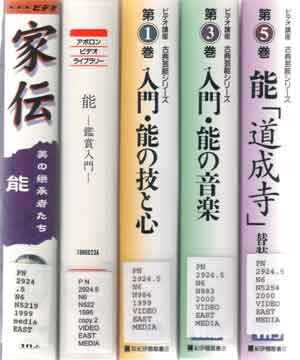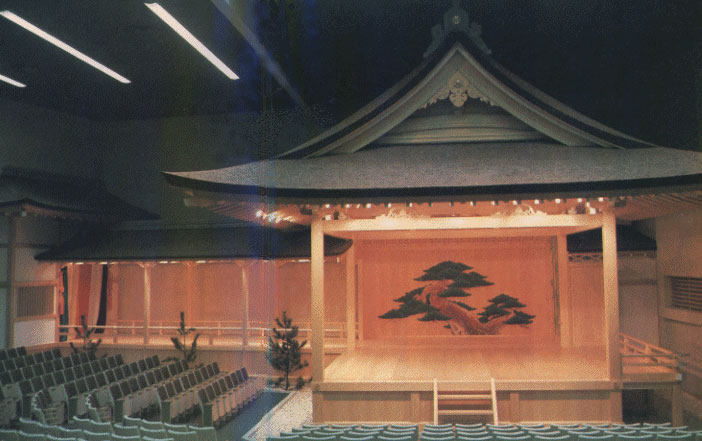Welcome to the portion of this web site devoted to Noh DRAMA for the Society for Asian Arts Fall 2005 Lecture Series
+ + +
Table of Contents for these pages
- Reading schedule for the entire series (on this page, below)
- Handouts for the two sessions devoted to Noh plays (on this page, below)
- Notes on audio-visual materials presented during the two sessions devoted to Noh plays (on this page, below)
- Misc. notes (on this page, below)
- Reading suggestions (on this page, below)
- Notes/graphics on the following plays (click on a play title): Takasago, Atsumori, Kinuta, Matsukaze, Sekidera Komachi, Funa Benkei, Yamamba
+ + +
The entire lecture series reading schedule is:
SEGMENT ONE -- JAPANESE POETRY
Session One (Oct 2): Poetry Reader 1-19
Session Two (Oct 9): Poetry Reader 20–end
SEGMENT TWO -- MEMOIRS BY ARISTOCRATIC WOMEN OF HEIAN JAPAN
Session Three (Oct 16): Sei Shonagon's Pillow Book (entire)
Session Four (Oct 23): Nijo's Confessions of Lady Nijo (entire)
SEGMENT THREE -- NOH DRAMA
Session Five (Oct 30): the plays 'Takasago,' 'Atsumori,' 'Kinuta'
Japanese No Dramas. Translated by Royall Tyler. Penguin Classics. ISBN 0140445390
Session Six (Nov 13--note there is no class Nov 6): the plays 'Matsukaze,' 'Sekidera Komachi,' 'Funa Benkei' and 'Yamamba'
same source as above
+ + +
Handouts for Segment Three - Noh Drama
Handout 9 (Session 5, Oct 30): Schema of Noh masks inserted with masks used in 'Takasago' 'Atsumori' and 'Kinuta'
Handout 10 (Session 5, Oct 30): Noh miscellaneous
Handout 11 (Session 6, Nov 13): Schema of Noh masks inserted with masks used in 'Matsuzake' 'Sekidera Komachi' 'Funa Benkei' and 'Yamamba'
+ + +
Notice regarding audio-visual material presented during the October 30 lecture (Session 5)
Below are the call numbers of the VHS tapes I borrowed from the East Asian Library Annex (California Hall, Basement) for Session 5. All are in Japanese only. The loan period for me was 1 week. I don't think this was for faculty only, but you might want to ask before making the trip there. (NOTE: The 'Dojoji' VHS tape is also available as a 2-disc dvd. The dvd has additional materials.)

PN2924.5 N6 N5219 1999 — Kaden
This was the video from which I drew the clips regarding the 25th generation master of the Kanze noh family, including masks, an original book written by Zeami, the process of orimono (brocade), the cord that is used for drums, etc.
PN2924.5 N6 N522 1995 — Noh Kansho nyumon
I did not show this video on October 30, but I had excepted from it a short on music, various masks and highlights of a noh play called Adachihara
PN2924.5 N6 N984 1999 — Nyumon Noh no waza to kokoro
I played this VHS showing various dance gestures (from the noh play Ama) with their meaning explained, donning of the costume before the play, some portions of a noh performance (the noh play Kazuraki)
PN2924.5 N6 N983 2000 — Nyumon Noh no ongaku
I have not show this VHS, nor seen it myself. The title translates as Introduction: Noh music
PN2924.5 N6 N5254 2000 — Nyumon Dojoji
I have not show this VHS, nor seen it in its entirety. The title translates as Introduction: Dojoji. This is one of the most famous, or at least frequently performed and referenced of noh plays. I believe it contains the entire play, with some comments as well.
+ + +
1. I will not be including a graphic for the noh stage. The one on page 21 of Tyler is quite good. Please note that the manner of getting on stage requires entering from the left and proceeding along a long walkway, with first , second and third pine markers. These are points along the way where actors might pause and tell some of their story, or describe the journey they undertake.
If you would like to see this map in Japanese, with more details, please go to this link:
2. Here is a link to a bilingual web site introducing various aspects of Noh theater: Noh_The_Palace_of_Hana_and_Yugen
+ + +
General on Noh
Quinn, Shelley Fenno. Developing Zeami: the Noh actor's attunement in practice. Honolulu: Univ of Hawai’I Press, 2005.
Milne-Tyte, Ashley, ed. Sculpture in silk: costumes from Japan's Noh theater. New York: Art Capital Group, 2003. / [editor Ashley Milne-Tyte].<2003>
Terasaki, Etsuko. Figures of desire: wordplay, spirit possession, fantasy, madness, and mourning in Japanese Noh plays. Ann Arbor: Center for Japanese Studies, Univ. of Michigan, 2002.
Goff, Janet Emily. Noh drama and The tale of Genji: the art of allusion in fifteen classical plays. Princeton: Princeton UP, 1991.
Hare, Thomas Blenman. Zeami's style: the noh plays of Zeami Motokiyo. Stanford: Stanford UP, 1986.
On Ono no Komachi
Hirshfield, Jane, trans. The Ink Dark Moon: Love Poems by Ono no Komachi and Izumi Shikibu, Women of the Ancient Court of Japan (Vintage Classics) Translations of all of Komachi's famous poems, plus many by Izumi Shikibu
Teele, Roy E. Ono No Komachi: Poems, Stories and No Plays. Introduces poems, medieval stories and the five classical and one modern plays that take Komachi as the protagonist
Strong, Sarah M. “The Making of a Femme Fatale. Ono no Komachi in the Early Medieval Commentaries.” Monumenta Nipponica Vol 49 No 4 (winter, 1994) Sarah M. Strong argues that the source of her “bad” reputation is medieval, not earlier
Classical Japanese Literature
and Culture Web Site
(click to return to
this web site's
Top/Main page)
